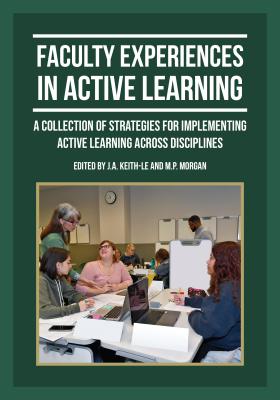Faculty Experiences in Active Learning: A Collection of Strategies for Implementing Active Learning Across Disciplines
Synopsis
For decades, if not more, the pedagogy of choice for higher education was the lecture: students sat quietly in a large classroom, stared at the teacher while the teacher lectured about a subject some students knew nothing about. Students were discouraged from talking to fellow classmates and teachers, but were encouraged to take notes. However, with new technologies, including computers, the internet, cell phones, smart devices, and social media, pedagogy has changed drastically. Students are now asked to multitask (listen, watch, read) not just take notes on the lecture. These changes require effective teaching pedagogy that engages multiple human technologies--speaking, hearing, responding, interacting, organizing, among others--a pedagogy that is called active learning.
Faculty Experiences in Active Learning, a book authored by twenty-four faculty and administrators, works to ignite a culture of active learning in higher education at the University of North Carolina at Charlotte. UNC Charlotte has been working to become a national leader in active learning transformation since 2014. The University promotes the use of active learning pedagogy through a faculty community of practice called the Active Learning Academy and provides supporting spaces for active learning through construction and renovations of classrooms to be active learning centers. This book, authored by Active Learning Academy members, was written for higher education faculty and students planning to teach at the post-secondary level and is a guide for considering the diverse pathways that active learning can take based on student population, approach, discipline, and learning environment.
The chapters in this book cover a range of topics on active learning: implementing logistics and strategies for getting started with active learning methods, using flipped classroom models, evaluating student engagement, addressing accessibility in active learning classrooms, and experimenting with adaptive academic technologies. Design patterns for planning active learning engagement in your classroom are provided along with examples of pitfalls that can occur with each activity and best practices for using activities successfully.
Introduction: Leveraging People, Space, and Systems to Ignite Active Learning
Chapter 1: Logistics of Active Learning
Chapter 2: Strategies to Incorporate Active Learning Practice in Introductory Courses
Chapter 3: A Fully Flipped Active Learning Course
Chapter 4: Converting a Traditional Class to Active Learning
Chapter 5: POGIL Learning Cycle as a Model for Active Learning
Chapter 6: Addressing Access in Active Learning
Chapter 7: A Learning Analytics Approach to Assessing Student Risk in Active Learning
Chapter 8: A Model for Mentoring Faculty and Teaching Assistants in Active Learning
Chapter 9: Active Learning Beyond the Classroom: Community-Engaged Learning Case Studies
Chapter 10: Design Patterns for Active Learning

Downloads
- Book Manuscript Book Manuscript
- Introduction Introduction
- Chapter 1 Chapter 1
- Chapter 2 Chapter 2
- Chapter 3 Chapter 3
- Chapter 4 Chapter 4
- Chapter 5 Chapter 5
- Chapter 6 Chapter 6
- Chapter 7 Chapter 7
- Chapter 8 Chapter 8
- Chapter 9 Chapter 9
- Chapter 10 Chapter 10

